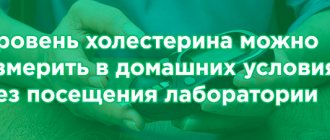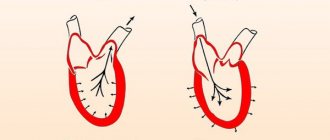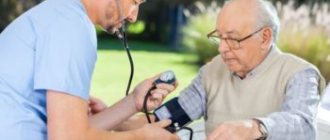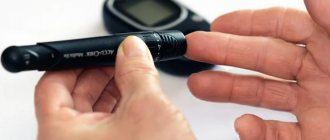At the end of the 20th and beginning of the 21st centuries, diseases of the cardiovascular system acquired the nature of a pandemic, being the main cause of disability and death in the population of economically developed countries. The main role in circulatory disorders in arterial vessels belongs to atherosclerosis.
Atherosclerosis is a chronic disease of the arteries that occurs as a result of lipid metabolism disorders and is accompanied by the deposition of cholesterol and its “bad” fractions in the vessel wall. Deposits form atherosclerotic (cholesterol) plaques on the walls of blood vessels. The subsequent growth of connective tissue in them (sclerosis), and calcification (calcium deposition) of the vessel wall lead to deformation and narrowing of the lumen until complete blockage.
When the arteries supplying the heart are damaged, a phenomenon called angina pectoris (chest pain) occurs and, as a result, acute myocardial infarction may develop.
Damage to the arteries supplying the brain causes either a transient (micro-stroke) or persistent (stroke) disturbance of cerebral circulation. Deposition of cholesterol in the arteries of the extremities is the cause of the development of lameness, pain in the calf during exercise, and gangrene of the extremity. Atherosclerosis of the abdominal arteries leads to intestinal ischemia and gangrene. Possible narrowing of the renal arteries due to the accumulation of cholesterol leads to a pronounced increase in blood pressure.
Risk factors for the development of atherosclerosis
- hypertension (systolic blood pressure >140 mm Hg, diastolic blood pressure >90 mm Hg),
- alcohol abuse,
- smoking (the most dangerous factor),
- sedentary lifestyle,
- unhealthy diet
- hereditary predisposition,
- obesity,
- increased cholesterol in the blood (total cholesterol >5 mmol/l, “bad” cholesterol >3 mmol/l, a-cholesterol >50 mg/dl,
- diabetes,
- emotional overstrain.
Such a high probability of atherosclerosis requires timely provision of therapeutic and preventive assistance, because it is known that a person’s age is determined by the state of his vascular bed. In the popular scientific literature devoted to the problem of atherosclerosis, the expression “ cleansing of blood vessels ” is used. Although not a medical term, “ vascular cleansing ” defines a number of extremely relevant measures for the prevention and treatment of atherosclerosis:
- healthy lifestyle and prevention of atherosclerotic process in blood vessels,
- stabilization of the course of atherosclerosis in the presence of its clinical manifestations through pharmacological agents,
- surgical restoration of vascular patency in cases of severe manifestations of atherosclerosis.
18-20: Other products
There are many more foods that can be used to lower cholesterol. Ideally, you should consult a nutritionist on this matter, as he can select an individual diet taking into account the patient’s requirements. “Universal” products of this kind include walnuts or apple cider vinegar.
Propolis
Propolis is no less beneficial for blood vessels than honey. At least there are more minerals in the composition.
However, it may cause an allergic reaction. It's better to start with small doses . It is better to prepare alcoholic infusions with propolis. They are especially useful for diabetes.
Baking soda
Oddly enough, soda can also be used for cleansing. The positive effect is achieved by regulating salt metabolism and accelerating the elimination of sodium combinations.
This is extremely important for the heart.
Apple vinegar
Apple cider vinegar contains a combination of organic acids, many of which literally break down cholesterol and lipids.
But you should use it carefully - no more than 100 milliliters per week. If more, there will be harm to the cardiovascular system.
Also pay attention to the infographic:
Diet for vascular atherosclerosis
First of all, it is supposed to reduce the consumption of fats (containing cholesterol) to such a level that they account for less than 30% of daily calories. In this case, the proportion of saturated fats should not exceed 10%. It is recommended that cholesterol intake be no more than 300 mg per day.
The next requirement for the diet is calorie restriction. In this case, the total caloric intake should not exceed 2500 calories per day. However, we must not forget about the variety and nutritional value of food. It is known, for example, that a deficiency of protein in food reduces resistance to stress, a lack of fatty acids contained in vegetable oils impairs brain function, etc.
Animal products
The consumption of saturated fat, or more simply cholesterol, can be reduced by reducing the amount of beef, pork and lamb. It is recommended to consume any meat products boiled.
It is necessary to remove the skin from the bird and avoid eating the internal organs of animals.
Fatty fish, such as halibut, contain a completely different type of fat that helps dissolve cholesterol plaques in arteries affected by atherosclerosis. Experts from Duke University believe that even one fish meal a week may be enough to reduce the risk of an unexpected heart attack by 50%. Interestingly, you can take fish oil instead of fish, which contains omega-3 fatty acids and lowers cholesterol.
Also, the diet should satisfy the body's needs for vitamin B6. It is actively involved in the processes of fat metabolism, in the transport and breakdown of cholesterol, and in organic iodine, which increases the synthesis of thyroid hormones. Thus, it stimulates the processing of dangerous cholesterol.
For this purpose, it is recommended to include seafood in the diet:
- seaweed dishes,
- squid,
- scallop,
- mussels, etc.
These are the products that lower cholesterol and “clean” blood vessels .
Products of plant origin
Vegetable oil contains “healthy” polyunsaturated fats. Olive oil is considered the most beneficial among vegetable fats. Try to replace them with other types of fats that contain bad cholesterol. Preference should be given to unrefined, cold-pressed olive oil. Because it contains a record amount of antioxidants that are beneficial for the heart and blood vessels, preventing the development of atherosclerosis. This oil is also involved in cleaning blood vessels from cholesterol.
But you can’t get carried away with vegetable oils either! This is often forgotten in recommendations. The fact is that an excess of polyunsaturated fatty acids can lead to a decrease in good cholesterol, which has an anti-sclerotic effect.
Cholesterol intake can be reduced by reducing the consumption of egg yolks (4 yolks per week) and organ meats:
- brain,
- kidneys,
- liver.
55-60% of daily calories should be provided by complex carbohydrates:
- vegetables,
- whole grain products,
- fresh fruits.
An important point is the inclusion of wholemeal products in the diet. The substances contained in the shells of grain crops bind and remove from the body cholesterol contained in food, as well as salts of heavy metals, nitrates and nitrites, carcinogens. Whole grain bread, wheat bran and oat bran contain coarse fiber. The norm is at least 20 g of fiber per day.
One of the richest sources of omega-3 fatty acids is flaxseed. Canadian cardiologists have found that regular consumption of flaxseed provides reliable protection against the formation of blood clots and cholesterol deposition in the arteries, leading to heart attack and stroke. The risk of heart attack can be reduced by up to 40%. 2 tbsp per day is enough. tablespoons of flaxseed, which can be added to porridge, salads and other dishes. Flaxseed should be stored in the refrigerator.
In fact, all of the above products can be classified as traditional methods of treating vascular atherosclerosis.
8-10: Berries
The composition of the berries necessary for blood vessels is quite similar to ordinary fruits, but they have several significant advantages:
- high content of “complex” glucose (therefore they can be included in the diet for diabetes);
- the presence of fatty oils (which can replace animal fats);
- a wide combination of vitamins (there are over 10 of them in rowan).
Kalina
In addition to vitamin C and B vitamins, it contains phytosterols - a class of substances of plant origin that act as mediators on the human body. That is, they provoke various kinds of biochemical processes.
Phytosterols, which are found in viburnum, accelerate the absorption of vitamin E, which is precisely necessary for normal hematopoiesis.
Viburnum also helps remove accumulated toxins from the blood. Moreover, it is better to use it in dried form.
Cranberry
Cranberries contain a huge amount of vitamin C, so it is almost impossible to consume them fresh. But it is an excellent preservative.
And the tincture of cranberries with garlic and lemon helps make blood vessels more elastic - in this case, cholesterol is practically not deposited on them even in old age.
Cranberry slightly helps to slightly dissolve atherosclerotic plaques, accelerating the breakdown of lipids. But you still won’t be able to completely get rid of them.
Rowan
Black rowan is more suitable for cleansing blood vessels. Its key benefits are lowering low-density cholesterol levels and increasing the synthesis of erythrocytes (red blood cells).
Just keep in mind that in excess, rowan can be harmful. Most often this ends in gastritis or stomach ulcers .
Diet of cardiac patients
It is necessary to limit table salt and include foods rich in potassium salts: baked potatoes, green onions, parsley, apricots, dried apricots, figs, prunes, apricots, bananas. Coffee beans contain a lot of potassium, but instant coffee does not! And also in black tea leaves. Green tea contains several powerful antioxidants that lower cholesterol and help normalize blood pressure. 3 teaspoons of green tea are poured into 0.5 liters of boiling water, steeped for 10 minutes and filtered. This amount is enough for a day.
It is highly recommended to distribute the diet into 5-6 meals. The last meal should be no later than 18-19 hours.
Eating any vegetables and fruits is beneficial. It is advisable to consume from 5 to 7 different types daily. Eggplants occupy a special place; they help eliminate cholesterol and also reduce its content in the blood and in the walls of blood vessels.
Nuts have a similar effect:
- peanut,
- walnuts,
- cashew nuts,
- hazel,
- almond,
- hazelnut.
Research shows that eating 150g of shelled nuts per week reduces the risk of coronary artery disease and heart attack by 33% in some patients. However, you should not get carried away with nuts, since these are very high-calorie foods that contribute to weight gain.
Cabbage is very useful:
- broccoli,
- Brussels sprouts
- white cabbage,
- colored.
They contain antioxidants and other valuable biologically active substances that are beneficial for blood vessels and the heart.
It is recommended to eat 2-4 sweet and sour apples daily. Black currants, shadberry and garlic are useful.
Traditional methods of treating vascular atherosclerosis are mainly associated with the use of healthy products that can be found in any garden and summer cottage.
What is cholesterol for?
It is important to note that it is vital for a living organism. This substance is included as a material for building the cell wall. The higher its content, the denser the wall and the more capable of survival, which generally has a beneficial effect on the human body. It also protects against cell destruction by free oxygen radicals. Contained in the skin, and under the influence of solar ultraviolet rays it is converted into vitamin D, which, in turn, is necessary for calcium metabolism.
In the liver, bile acids are formed from cholesterol, which are used for the absorption and breakdown of fats in the small intestine. More than 80% of this substance is formed daily in the body, the remaining percentage comes with food.
With a decrease in dietary intake, men experience a decrease in sexual activity, and women experience amenorrhea (absence of menstruation). In addition, with a strict hypocholesterol diet in women of reproductive age, the likelihood of pregnancy is reduced.
Cholesterol is an essential component for myelinated fibers in the brain and is also required for serotonin receptors. Serotonin is responsible for a good mood and ensuring favorable conditions for the functioning of the brain.
Cholesterol is necessary for favorable conditions for brain function.
Non-drug methods for the prevention and treatment of vascular atherosclerosis
- to give up smoking,
- anti-atherosclerotic diet,
- active lifestyle - regular dosed physical activity,
- maintaining psychological and physical comfort,
- weight loss.
The diet is prescribed for 3-4 months, after which tests are monitored. If laboratory data and well-being indicate an improvement, then monitoring of the patient continues, but the diet is not removed. If no effect is obtained (cholesterol levels are even higher than normal), then the diet is tightened. If after another 3 months no effect is observed, then modern medications from the statin group are added.
Blood cleansing in traditional medicine
In folk medicine there are many recipes for blood purification. The Tibetan method allows you to clean arteries from cholesterol plaques. This composition strengthens the vascular walls and restores their elasticity.
350 g of garlic should be crushed and placed in a dark glass container. The mixture should be poured with a glass of alcohol and left for 10 days in a dark place at room temperature. Then squeeze out the contents through gauze.
For the medicine you will need a sticky liquid obtained during the squeezing process. The method of application is as follows: 1 drop of liquid is mixed with a glass of boiled milk and drunk. With each meal, the number of drops is increased by 1 (1 - breakfast, 2 drops at lunch, 3 - dinner, 4 - next breakfast, etc.). Having reached 15 drops, begin the countdown, reducing to 1 drop.
After 10 days of treatment according to the regimen, they begin to take 25 drops per glass of milk three times a day. Drink until the mixture runs out.
It is believed that such a course is enough for 5 years.
In folk medicine, nettle, potatoes, echinacea, kombucha and other remedies are also used to cleanse the blood.
Surgical methods for restoring blood flow (cleaning blood vessels)
Surgical methods of cleaning blood vessels are used for clinically pronounced manifestations of vascular insufficiency. In case of damage to the abdominal aorta and arteries of the lower extremities, the indications are:
- reducing the distance of pain-free walking to less than 200 meters,
- pain in the foot at rest,
- development of trophic ulcers and peripheral gangrene.
Surgical cleaning of blood vessels involves: removal of blood clots from the lumen of the artery, elimination of plaques narrowing or clogging the lumen of the vessel, the so-called endarterectomy. If it is impossible to locally remove obstacles in the lumen of the vessel, a new roundabout blood circulation path is created (bypass surgery).
Currently, surgeons have in their arsenal new, progressive methods of restoring or improving blood circulation in vessels, using X-ray endovascular interventions, during which it is possible to expand the lumen of the vessel (balloon plasty) and install a device to prevent narrowing of the vessel in the plasty area (stenting).
The problem of atherosclerosis cannot be eliminated by using any one method, even the most modern one. Treatment and prevention of atherosclerosis are complex and constant, with mandatory monitoring of their effectiveness.
What foods are best to avoid?
To strengthen the vascular system, it is important to limit the consumption of certain foods:
- dairy products and fatty meat dishes;
- smoked meats, semi-finished products, fast food;
- foods high in sugar;
- marinades and salt in large quantities;
- alcohol in excess of the norm;
- strong coffee and tea.
If you study the beneficial properties of foods and follow the rules for their use, you can easily provide your body with useful substances that will prolong youth and help maintain vigor and activity for many years!
Price
The cost of preparations for cleaning blood vessels is determined by the form of release and the manufacturer. The price is also affected by the number of tablets or capsules and the volume of ampoules (for drugs in the form of solutions for infusion). Cost of popular medications for blood vessels:
| Name of the drug | Volume, quantity | Price, rubles |
| Angiovitis | 60 tab. | |
| Atorvastatin | 30 tab. | 270 |
| Dihydroquercetin | 100 tab. | 550 |
| Troxevasin gel | 40 g | 200 |
| Clofibrate | 30 tab. | 450 |
| Lovastatin | 30 tab. | 370 |
| Cavinton | 10 ampoules of 2 ml | 220 |
| Lyoton | 50 g | 470 |
| Heparin ointment | 25 g | 65 |
| Verapamil | 30 tab. | 35 |
| Vinpocetine | 50 tab. | 50 |
| Cardiomagnyl | 30 tab. | 130 |
| Thrombo ACC | 28 tables | 50 |
| Vitrum | 100 tab. | 1500 |
| Cinnarizine | 50 tab. | 40 |
| Antiox | 30 capsules | 2000 |
| Doppelhertz Active | 30 tab. | 150–200 |
Symptoms of thrombosis
There are two main forms of venous thrombosis: deep vein thrombosis (DVT) and superficial vein thrombosis (thrombophlebitis). The first form is the most dangerous and may be asymptomatic at the onset of the disease.
Symptoms of thrombosis of the superficial veins of the lower extremities
- heaviness in the legs
- pain along the thrombosed veins, limitation of movements
- swelling of a nearby limb
- redness of the skin along the hardened vein
- increased skin sensitivity
- deterioration in general health: weakness, malaise, chills, increased body temperature
Symptoms of deep vein thrombosis
- feeling of fullness and heaviness in the limb
- pain on the inside of the foot, leg, thigh
- swelling of the entire limb or part of it
- the skin of the affected leg becomes pale and bluish in places
- the temperature of the affected limb is 1.5-2ºС higher than that of the healthy one
- bursting pain in a limb
If you experience any symptoms of thrombosis, consult your doctor immediately. Prevention of thrombosis Prevention of thrombosis is a whole series of measures that are aimed at improving the rheological properties of blood (blood and plasma viscosity), preventing heart and vascular diseases, strengthening blood vessels, normalizing blood flow, etc.
To avoid blood clots, you need:
- Adhere to a special diet that prevents the formation of blood clots.
- Give up bad habits and spend more time in the fresh air: fight physical inactivity, give yourself adequate physical activity.
- Strengthen the immune system, thereby preventing the development of infectious processes.
- Wear compression socks and special stockings made of jersey.
- Properly organize your daily routine, carefully plan long trips by plane or car, when you have to spend many hours in a sitting position.
- Do not wear outerwear, underwear and accessories that cause discomfort and put pressure on certain parts of the body (for example, tight jeans, belts, corsets, uncomfortable shoes).
- Avoid general hypothermia. Do not walk in too hot weather, try not to take hot baths.
- Contact your doctor to prescribe medications to prevent thrombosis. Attention: medications cannot be taken without agreeing on the dosage with a specialist.









